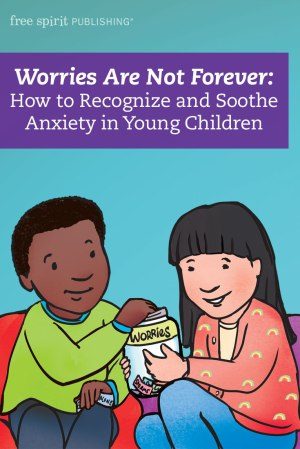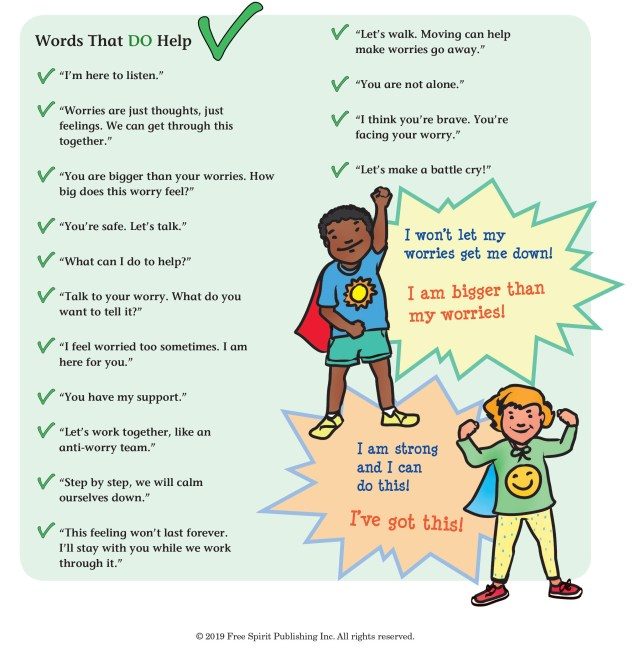 When I tell parents and teachers the title of my new children’s book, Worries Are Not Forever, they often say something like, “I need that immediately” or “Do you have one for adults too?” They laugh a little when they say that, but the underlying meaning is clear: We’re experiencing greater stress in our society, and this stress affects children of all ages—and their families.
When I tell parents and teachers the title of my new children’s book, Worries Are Not Forever, they often say something like, “I need that immediately” or “Do you have one for adults too?” They laugh a little when they say that, but the underlying meaning is clear: We’re experiencing greater stress in our society, and this stress affects children of all ages—and their families.
The Journal of Developmental & Behavioral Pediatrics notes that anxiety is rising among America’s young people. The study was based on data collected from the National Survey of Children’s Health for kids ages 6–17, with researchers noting a 20 percent increase in anxiety diagnoses between the years 2007 and 2012. Although the study focused on kids and teens, we know that young children experience stress and worry as well. Because they’re still so young, toddlers and preschoolers have a harder time putting their feelings into words. It’s up to us as adults to notice when young children show signs of stress.
So what can you do if you’re worried that your child is worried? With preschoolers, kindergartners, or elementary-age children, look for body language and behaviors that may signal stress:
- biting nails, chewing hair, sucking on shirt sleeves
- being tearful or clingy
- agitation, pacing, fidgeting, outbursts, aggression
- appearing tired, sleeping poorly at night
- inability to focus in class
- changes in appetite
- avoidance of school, social occasions, or everyday activities
With toddlers, watch for:
- increased tears and tantrums
- disruptions in sleep
- frequent stomachaches
- chewing hair or sucking on thumb
- signs of distress or an inability to enjoy being with family and friends
It’s normal for toddlers to experience moments of being clingy, not wanting to be separated from a parent, or new fears of everyday items—like loud vacuum cleaners, the dark, or the bathtub drain. The toddler years are filled with lots of change and growth . . . and tears. But you’ll sense when a young child’s behavior is more challenging than usual and could be a result of increased stress and worry. What can you do about it? Dig deeper into the situation. Be reassuring. Let young children know that everyone worries, even adults. It may feel like the worries won’t ever go away, but they will. Worries don’t last forever.
Young children (all children) rely on us to be their supporters and role models. Show them they can come to you for help.
Here are some ways you can be a helper:
- Talk about fears. Young children have difficulty explaining their emotions. Prompts can be helpful: “Tell me what you need.” “Did that loud noise surprise you?” “Do you feel a little shaky?” “Are you jumpy inside?” “I’m here to help.” Let your child know that you’re there for support. If your child is older, encourage him or her to draw the worries or write about them. Are worried thoughts about something that already happened or might happen? Encourage children to reframe worried thoughts, express difficult emotions, and think about what may help.
- Teach how to self-soothe. You can help your child manage fears and worries by first recognizing the physical symptoms that may accompany these feelings: racing heartbeat, butterflies in the stomach, sweating, tearfulness. Children can take deep breaths to feel calmer, seek a quiet space, talk it out, do a “self-hug” (wrapping arms around oneself and squeezing), get a drink of water, cuddle something soft, use fidgets to distract themselves, or move around to make worries “move away.”
- Keep them moving. Take a walk with your child, go outside to play, stretch, jump, dance, do yoga, pet an animal—any kind of movement can help the body and mind calm down. If you’re at a desk or table, offer activities to keep small hands busy: coloring, shaping clay, cutting with safety scissors, making a collage, sorting objects, playing with puppets. Children of all ages need daily exercise to stay healthy and strong. But during times of stress, motion is an especially helpful tool for handling the physical symptoms anxiety may produce.
- Use calming language. Children of all ages can use a refrain to feel more secure when worries take over. Keep it simple: “I am fine. I am calm. I am safe.” Practice these words during peaceful times, and then encourage their use when stress arises. There’s something else to think about: Your words matter. Children are listening—so think before you speak. Avoid phrases like these that may pop out when you’re frazzled and frustrated: “Stop worrying.” “Don’t be a baby.” “You’re such a worrywart.” “Cut it out.” “Tough it out.” “Calm down!”
And speaking of negative phrases, what do you usually tell yourself when you’re worried? Any chance that the words above are similar to the ones you hear in your own mind during stressful times? If so, it’s not a bad idea to change them into something more positive! Be there for yourself, just like you want to be there for your children.
I’m a firm believer in the power of words. (Guess that’s why I became a writer.) Our words can hurt or our words can help. When kids worry, give them language to change their situations and outlooks, and to help keep worries at bay.

“Worries Are Not Forever: How to Recognize and Soothe Anxiety in Young Children” originally appeared at freespiritpublishingblog.com. Copyright © 2020 by Free Spirit Publishing. All rights reserved.

